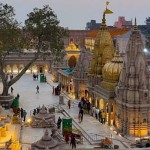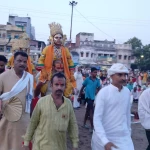The Kashi Vishwanath Temple, located in Varanasi, Uttar Pradesh, India, holds immense spiritual and historical significance. Dedicated to Lord Shiva, the temple is one of the twelve Jyotirlingas, the holiest of Shiva temples. Varanasi, also known as Kashi, is considered one of the oldest continuously inhabited cities in the world, and the Kashi Vishwanath Temple is deeply intertwined with its history.

Earliest Constructions
The original Kashi Vishwanath Temple is believed to have been built by King Vikramaditya approximately 2500 years ago. This places the temple's inception around the 6th century BCE, during an era when Varanasi was emerging as a significant cultural and religious hub. King Vikramaditya, a legendary ruler, is often credited with constructing many temples and promoting Hinduism.
Mentions in Ancient Texts
The temple's early existence is referenced in the Kashi Khanda of the Skanda Purana, an ancient text that is believed to date back to at least the 6th century CE. The Kashi Khanda describes the glory of Kashi and the importance of the Vishwanath Temple, highlighting its status as a major center of pilgrimage and worship.
The Temple Through the Ages
Throughout history, the Kashi Vishwanath Temple has faced numerous destructions and reconstructions. The original structure, attributed to King Vikramaditya, did not survive intact through the millennia. The temple was repeatedly demolished by various invaders and subsequently rebuilt by devout Hindu rulers and patrons.
Medieval and Modern Reconstructions
In the 11th century, the temple faced destruction at the hands of Mahmud of Ghazni. It was later rebuilt by Hindu kings who sought to restore its sanctity and grandeur. Another significant destruction occurred in the 17th century when the Mughal Emperor Aurangzeb ordered the demolition of the temple. On the same site, he built the Gyanvapi Mosque, which still stands adjacent to the temple complex today.
The current structure of the Kashi Vishwanath Temple was constructed in 1780 by the Maratha queen, Ahilyabai Holkar of Indore. Her dedication to Hinduism and her efforts to rebuild many sacred sites across India are well-documented. The temple's gold-plated spire and dome, which add to its visual splendor, were added in the 19th century by Maharaja Ranjit Singh, the Sikh ruler of Punjab.
Architectural and Cultural Importance
The Kashi Vishwanath Temple is not only a pivotal religious site but also an architectural marvel. The temple's design is an excellent example of North Indian temple architecture, featuring intricate carvings, lofty spires, and a serene courtyard that accommodates thousands of devotees daily.
The temple complex includes several smaller shrines dedicated to various deities, enhancing its spiritual ambiance. The sacred Ganges River flows nearby, adding to the temple's sanctity, as pilgrims often perform rituals and take holy dips in the river before offering prayers at the temple.

Conclusion
The Kashi Vishwanath Temple, with its ancient origins and rich history of destruction and reconstruction, stands as a testament to the enduring spirit of Hinduism and the unwavering devotion of its followers. From its legendary inception by King Vikramaditya to its current grandeur, the temple continues to be a beacon of faith, drawing millions of pilgrims from around the world.
Today, the Kashi Vishwanath Temple remains a vibrant center of worship and cultural heritage, embodying the timeless traditions and spiritual essence of Varanasi. Its storied past and architectural magnificence ensure that it will remain a significant landmark for generations to come.











